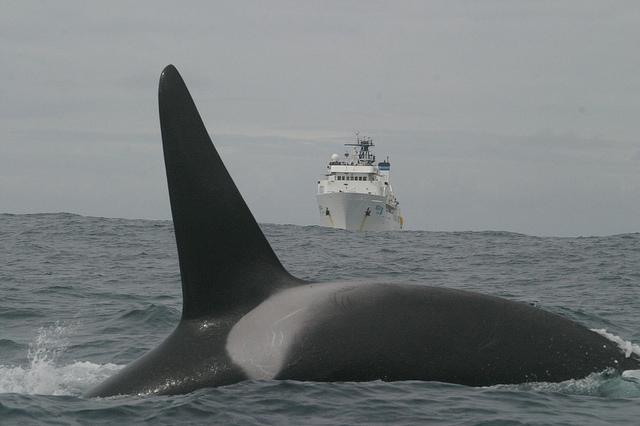Environmental, indigenous groups accuse Navy of damaging marine mammals
Orca whale populations in the Pacific Northwest are carefully monitored. Disturbances in their habitat including Navy sonar have severely depleted the population of Orca whales in recent years. (Photo courtesy of Shannon Rankin for the NOAA ).
Environmentalists and indigenous people filed a federal lawsuit late last month in an effort to stop the U.S. Navy from using sonar in the biologically rich Northwest Training Range.
The range stretches up the Pacific coast from Northern California to the Canadian border. The Navy conducts military training exercises in the range, extensively using sonar. The range is also home to a wide range of marine mammals — including endangered killer whales. Zak Smith, attorney for the National Resources Defense Council, one of the plaintiffs, argues the Navy’s use of sonar is damaging these threatened populations.
“Sonar can have a wide-ranging effect on marine mammals,” Smith said. “It can be anything from a significant behavioral disturbance … such as feeding or migrating or mating, to the other end of the spectrum, which would be temporary or permanent hearing loss, which for marine mammals is the equivalent of to us going blind. And also of course, just death, can result.”
The biologically rich area is home not only to native species of marine mammals, but also migratory ones as well.
“You have the seven resident killer whales, which are a very endangered species that lives in the Puget Sound area,” said Smith. “There’s migratory species of grey whales and others that pass through the area. And then there are those species like harbor porpoises that live there year-round.”
According to the plaintiffs, the Navy is aware of the harmful effect of sonar on marine mammals. In 2008,the National Resources Defense Council took the Navy to federal court and demanded it adopt safety measures to protect wildlife during training exercises. The Navy appealed the verdict all the way to the Supreme Court, where, in a split decision, the Navy was required it to adopt most of the proposed safety measures.
In 2010, a permit issued by the National Fisheries Service has granted the Navy expanded access to the area, allowing it to “take” (kill) marine mammals while conducting operations.
“The Navy is allowed to have these harmful impacts over 120,000 times per year in that training area,” Smith said.
The plaintiffs say they aren’t aiming to end Navy activity in the area — but they do want the impact on marine species mitigated. They hope to modify the permits issued by the National Fisheries Service in order to limit the damages caused by Navy activity.
“The Navy’s range is the size of the state of California. And currently, NMFS, the National Marine Fisheries Service, doesn’t set aside one square inch where that activity shouldn’t take place,” Smith said. “That is simply what we’re seeking, that the NMFS set aside biologically rich areas, like the Olympic Coast National Marine Sanctuary, where sonar won’t be allowed to be conducted.”
